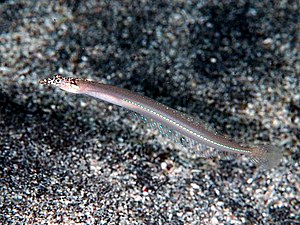Sand divers
| Sand divers | ||||||||||||
|---|---|---|---|---|---|---|---|---|---|---|---|---|

Trichonotus filamentosus |
||||||||||||
| Systematics | ||||||||||||
|
||||||||||||
| Scientific name of the family | ||||||||||||
| Trichonotidae | ||||||||||||
| Bleeker , 1859 | ||||||||||||
| Scientific name of the genus | ||||||||||||
| Trichonotus | ||||||||||||
| Bloch & Schneider , 1801 |
The sand divers ( Trichonotus ) ( size : thrix , - ikos = hair, noton = back) are a genus of perch-related marine fish. They occur close to the coast in the tropical Indo-Pacific and the Red Sea .
features
Sand divers become eleven to 22 centimeters long. Their body is extremely elongated, band-shaped and covered by relatively large round scales. The cross section is round to upright oval. The dorsal and anal fins are long. The first rays of the dorsal fin are elongated like a thread in male fish of some species, reach behind the middle of the body and are used as signals. The lateral line organ runs exactly along the middle of the body. The scales along the back of the sideline have deep V-shaped notches. The mouth is large and has small, pointed teeth, the lower jaw protrudes far. The pelvic fins are supported by a spine and five soft rays. Some species can move their eyes independently. The upper part of the eyes is covered by a few elongated scales.
Way of life
The fish live in groups in shallow water from a depth of five meters and feed on zooplankton floating one to three meters above the sea floor . The number of females exceeds the number of males. They probably have a harem made up of several females. In territorial disputes, the males spread their dorsal fin spines and the fan-shaped pelvic fins wide apart to impress. If they wear them on the body, they can hardly be distinguished from the females.
If sand divers feel threatened, they quickly dive headlong into the sandy seabed. Then they turn around in an arc in the ground, only to look out again at another point with their eyes.
Almost nothing is known about their reproduction. In the Red Sea they spawn at dawn. It is believed that they do not care for the brood .
Systematics
In the past, the sand divers were included in the polyphyletic subordination of the dragon fish (Trachinoidei), a taxon that is no longer used in modern systematics. In mid-2015, a team of researchers identified them as a sister group of the Gobioidei (goby-like i. E. S.) using comparative DNA analysis and assigned them to the order Gobiiformes (gob-like i. W. S.).
species
- Trichonotus arabicus Randall & Tarr, 1994
- Trichonotus blochii Castelnau, 1875
- Trichonotus cyclograptus (Alcock, 1890)
- Trichonotus elegans Shimada & Yoshino, 1984
- Trichonotus filamentosus (Steindachner, 1867)
- Trichonotus halstead Clark & Pohle, 1996
- Trichonotus marleyi (Smith, 1936)
- Trichonotus nikii Clark & von Schmidt, 1966
- Trichonotus setiger Bloch & Schneider, 1801
- Trichonotus somaliensis Katayama, Motomura & Endo, 2012
literature
- Hans A. Baensch / Robert A. Patzner: Mergus Sea Water Atlas Volume 7 Perciformes (perch-like) , Mergus-Verlag, Melle, 1998, ISBN 3-88244-107-0 .
- Joseph S. Nelson : Fishes of the World. Wiley, New York 2006, ISBN 0-471-25031-7 .
- Kurt Fiedler: Textbook of Special Zoology, Volume II, Part 2: Fish . Gustav Fischer Verlag Jena, 1991, ISBN 3-334-00339-6 .
Individual evidence
- ↑ Christine E. Thacker, Takashi P. Satoh, Eri Katayama, Richard C. Harrington, Ron I. Eytand, Thomas J. Near: Molecular phylogeny of Percomorpha resolves Trichonotus as the sister lineage to gobioidei (Teleostei: Gobiiformes) and confirms the polyphyly of trachinoids. Molecular Phylogenetics and Evolution, August 2015, doi: 10.1016 / j.ympev.2015.08.001
Web links
- Trichonotidae on Fishbase.org (English)
